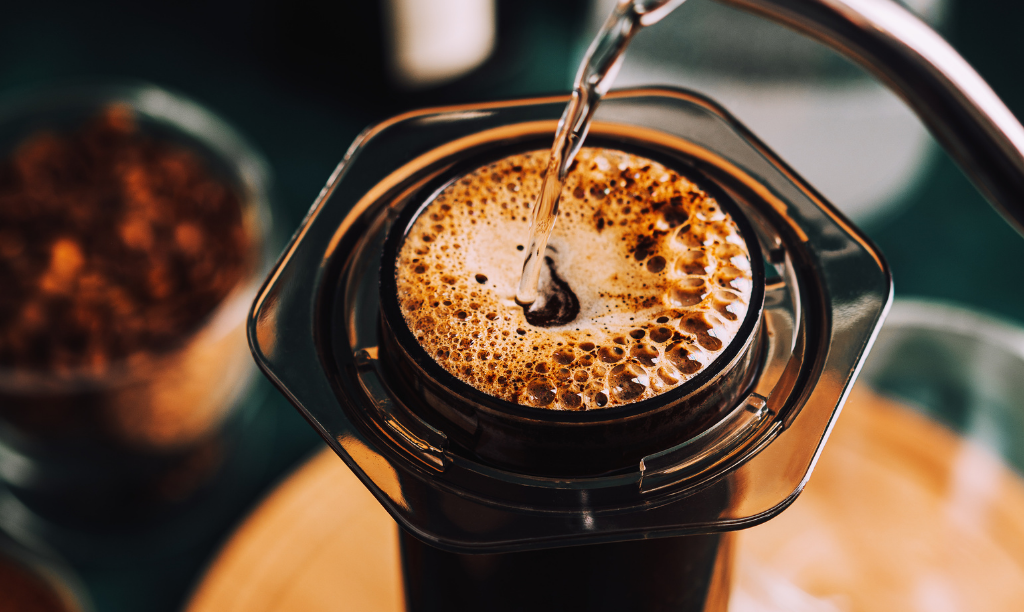The Ultimate Contrast of Popular Coffee Brewing Methods for Home Baristas
Wiki Article
The Science Behind Coffee Developing: Just How Temperature and Time Affect Your Drink
Comprehending the scientific research behind coffee developing reveals that temperature level and time are not plain variables however essential elements that determine the drink's taste account and overall quality. As we check out the nuances of these components, the concern emerges: how can one effectively equilibrium temperature and time to achieve that best brew?The Chemistry of Coffee Removal
The chemistry of coffee removal looks into the elaborate processes that transform raw coffee beans right into the fragrant beverage appreciated worldwide. This change mainly includes the solubility of numerous compounds present in the beans, which are influenced by variables such as grind dimension, water quality, and the brewing method utilized.Throughout the developing procedure, warm water acts as a solvent, drawing out soluble compounds, including caffeine, sugars, lipids, and acids, from the coffee premises. Each compound contributes to the taste account, fragrance, and body of the final beverage. For circumstances, acids are accountable for bright and tasty notes, while oils add to a rich mouthfeel.
The preliminary phases of brewing essence acids and sugars, leading to a pleasurable acidity, while prolonged extraction can lead to bitterness due to over-extraction of undesirable substances. Comprehending these chemical interactions is vital for enhancing developing strategies, as the balance in between extraction time and water temperature can dramatically affect the general quality of the coffee.
Suitable Brewing Temperatures
Discovering the ideal developing temperature is vital for unlocking the complete capacity of coffee tastes and fragrances - coffee brewing methods. Research study suggests that the optimal array for brewing coffee lies in between 195 ° F to 205 ° F(90 ° C to 96 ° C) Within this variety, the extraction process properly dissolves the desirable soluble substances in coffee beans, causing a delicious and balanced mugBrewing at lower temperature levels, such as below 195 ° F(90 ° C ), might lead to under-extraction, yielding an acidic and weak brew with muted tastes. On the other hand, developing at temperatures going beyond 205 ° F(96 ° C) can bring about over-extraction, generating a rough and bitter taste as a result of the extreme dissolution of undesirable substances, such as tannins.
Furthermore, the perfect developing temperature can vary relying on the coffee bean type and roast degree. Lighter roasts commonly profit from somewhat higher temperatures to improve their intricate flavor profiles, while darker roasts may be much better suited to lower temperatures to reduce anger.
Inevitably, maintaining precision in brewing temperatures is essential for accomplishing a harmonious equilibrium of tastes, making sure that every mug of coffee delivers a rewarding sensory experience.
Impact of Developing Time
Developing time plays a pivotal duty in determining the taste account and overall quality of coffee. The extraction procedure, which affects the preference, scent, and body of the beverage, is mainly based on for how long the coffee grounds touch with water. Shorter developing times can cause under-extraction, bring about a weak or sour taste, as insufficient soluble compounds are dissolved. Conversely, prolonged developing can bring about over-extraction, where unwanted compounds are released, causing an astringent or bitter preference.Optimal developing time varies depending on the approach made use of and the work size of the coffee. A French press generally calls for concerning four mins, while espresso removal is typically finished within 25 to 30 secs. It is vital to adjust brewing time in combination with other variables, such as water temperature level and coffee-to-water ratio, to achieve the preferred taste profile.
Recognizing the effect of developing time makes it possible for coffee lovers to improve their brewing strategies, ultimately improving the sensory experience of their cup (coffee brewing methods). With mindful attention to this variable, one can unlock the complete potential of the coffee, exposing its unique features and nuances
Brewing Approaches and Their Effects

As an example, methods like French press and cold brew allow for a longer steeping time, leading to a fuller body and durable taste because of raised removal of oils and soluble solids. Alternatively, coffee developing uses high pressure and a much shorter extraction time, creating a focused shot that highlights extreme flavors and a rich crema.
Pour-over techniques, such as Chemex or V60, provide an even more controlled extraction process, allowing the maker to adjust circulation price and water circulation, which can improve brightness and clarity. On the other hand, percolation techniques cycle water through the coffee grounds multiple times, leading to a stronger, frequently bitter flavor.
Lastly, using paper filters versus steel filters can More Bonuses likewise affect the final preference; paper filters normally generate a cleaner cup by trapping oils and fine fragments, while metal filters allow even more oils to travel through, adding to a fuller mouthfeel - coffee brewing methods. Comprehending these nuances can elevate the coffee experience dramatically
Tips for Developing Your Brew
A well-executed brew can change even the simplest coffee right into an amazing experience. To achieve this, interest to detail is crucial. Begin with premium, freshly baked beans, as their flavor account diminishes with time. Grind the beans just before making to make the most of quality, guaranteeing the work size matches your developing technique-- coarser for French press and finer for espresso.Water high quality plays an important duty; use filtered water devoid of contaminations. The optimal developing temperature ranges between 195 ° F and 205 ° F(90 ° C to 96 ° C ) Also hot can blister the coffee, while too great might under-extract flavors.
Timing is similarly crucial. For immersion methods, steeping for 3 to 5 mins is optimal, whereas drip techniques typically take around 5 mins. Experiment with brew times to discover your favored toughness.

Conclusion
In recap, the detailed partnership in between temperature level and time is paramount in the coffee brewing procedure. Complying with optimum developing temperature levels between 195 ° F and 205 ° F, along with exact timing tailored to every approach, ensures the wanted taste account is accomplished. Recognizing these clinical concepts equips individuals to refine their brewing strategies, inevitably bring about a much more delightful and well balanced coffee experience. Mastery of these factors is essential for any kind of coffee fanatic looking for excellence in their beverage.Understanding the science behind coffee developing reveals that temperature go level and time are not simple variables yet essential elements that determine the beverage's taste profile and total high quality. Understanding these chemical communications is essential for optimizing developing techniques, as the equilibrium in between removal time and water temperature can substantially influence the total high quality of the like this coffee.Developing time plays a pivotal duty in identifying the taste profile and overall high quality of coffee. By concentrating on these elements-- bean high quality, grind dimension, water temperature, steeping time, and proportion-- you can elevate your coffee developing process, resulting in a constantly premium cup.
In recap, the detailed relationship in between temperature and time is vital in the coffee developing process.
Report this wiki page